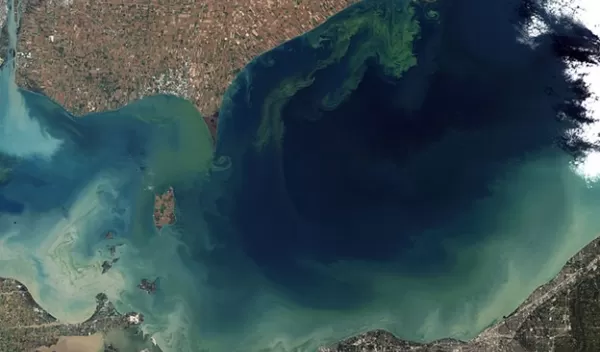
Models predict that planned phosphorus reductions will make Lake Erie more toxic
Reducing levels of the nutrient phosphorus to control harmful algal blooms in places such as Lake Erie is advantageous to toxic cyanobacteria strains, which can lead to an increase in toxins in the water, according to a new modeling study.
U.S. National Science Foundation-supported researchers at the University of Michigan and other institutions detail their findings in a paper published in Science.
"This study supports the idea that phosphorus reduction will successfully reduce the overall abundance of cyanobacteria, consistent with the goals of current policies," said University of Michigan environmental microbiologist and study co-author Gregory Dick. "However, it also suggests that reducing phosphorus will cause an increase in abundance of the subset of cyanobacteria that are able to produce toxin, resulting in more toxin overall."
Cyanobacteria, also known as blue-green algae, can produce toxins and deplete lakes of oxygen when they die. Phosphorus is an important nutrient for these algae, and efforts are underway worldwide to reduce phosphorus levels and inhibit the growth of cyanobacteria.
However, as the total number of cyanobacteria decreases, the remaining cyanobacteria have more of another important nutrient available: nitrogen. And higher concentrations of nitrogen help certain cyanobacteria to produce a toxin that protects them against damage resulting from oxidation.
"The big advance here was to integrate our understanding of the microbiology of the blooms into predictive models," said Dick.
The researchers simulated how cyanobacteria behave in Lake Erie. They call for a shift in thinking about water management and adoption of an approach that reduces not only phosphorus but also nitrogen loading in bodies of water.
Cyanobacteria can be dangerous for both pets and people. In August 2014, nearly half a million people in the Toledo area were without tap water for nearly three days because of contaminated drinking water. A type of blue-green algae, Microcystis, had produced high levels of the liver toxin microcystin in Lake Erie.
Because phosphorus is a nutrient that is available only to a limited extent in nature, efforts have focused on cutting down the use of phosphates as fertilizers in agriculture and reducing the phosphorus content of wastewater to slow down the growth of blue-green algae, even in larger bodies of water such as Lake Erie.
University of Michigan researchers took field measurements at Toledo's drinking water intake in Lake Erie, then used environmental genomic techniques to quantify the proportion of toxin-producing and non-toxin-producing Microcystis cells in the Lake Erie blooms. Reducing phosphorus inputs alone may be insufficient for managing harmful cyanobacteria blooms, the team found.


